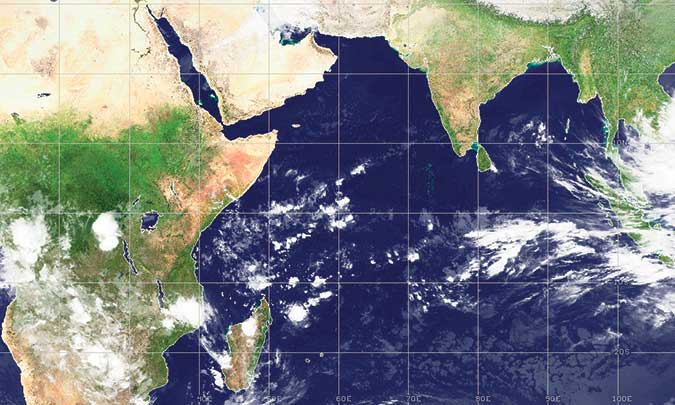News
Indian Ocean temps vary from side to side

New research on the Indian Ocean dipole shows how melting ice water from massive glaciers can ultimately lead to droughts and flooding in East Africa and Indonesia.With a new analysis of long-term climate data, researchers say they now have a much better understanding of how climate change can cause sea water temperatures on one side of the Indian Ocean to be so much warmer or cooler than the temperatures on the other—a phenomenon that can lead to sometimes deadly weather-related events like megadroughts in East Africa and severe flooding in Indonesia.
The analysis, described in a new study in Science Advances, compares 10,000 years of past climate conditions reconstructed from different sets of geological records to simulations from an advanced climate model.
The findings show that about 18,000 to 15,000 years ago, as a result of melted freshwater from the massive glacier that once covered much of North America pouring into the North Atlantic, ocean currents that kept the Atlantic Ocean warm weakened, setting off a chain of events in response. The weakening of the system ultimately led to the strengthening of an atmospheric loop in the Indian Ocean that keeps warmer water on one side and cooler water on the other.
This extreme weather pattern, known as a dipole, prompts one side (either east or west) to have higher-than-average rainfall and the other to have widespread drought. The researchers saw examples of this pattern in both the historical data they studied and the model’s simulation. They say the findings can help scientists not only better understand the mechanisms behind the east-west dipole in the Indian Ocean, but also one day help to produce more effective forecasts of drought and flood in the region.
“We know that in the present-day gradients in the temperature of the Indian Ocean are important to rainfall and drought patterns, especially in East Africa, but it’s been challenging to show that those gradients change on long time-scales and to link them to long-term rainfall and drought patterns on both sides of the Indian Ocean,” says James Russell, a study author and professor of earth, environmental, and planetary sciences at Brown. “We now have a mechanistic basis to understand why some of the longer-term changes in rainfall patterns in the two regions have changed through time.”
In the paper, the researchers explain the mechanisms behind how the Indian Ocean dipole they studied formed and the weather-related events it led to during the period they looked at, which covered the end of the last Ice Age and the start of the current geological epoch.
The researchers characterize the dipole as an east-west dipole where the water on the western side—which borders modern day East African countries like Kenya, Ethiopia, and Somalia—is cooler than the water on eastern side toward Indonesia. They saw that the warmer water conditions of the dipole brought greater rainfall to Indonesia, while the cooler water brought much drier weather to East Africa.
That fits into what is often seen in recent Indian Ocean dipole events. In October, for example, heavy rain led to floods and landslides in Indonesian islands of Java and Sulawesi, leaving four people dead and affecting over 30,000 people. On the opposite end, Ethiopia, Kenya, and Somalia experienced intense droughts starting in 2020 that threatened to cause famine.
The changes the authors observed 17,000 years ago were even more extreme, including the complete drying of Lake Victoria—one of the largest lakes on Earth.
“Essentially, the dipole intensifies dry conditions and wet conditions that could result in extreme events like multi-year or decades-long dry events in East Africa and flooding events in South Indonesia,” says Xiaojing Du, a postdoctoral researcher in the Institute at Brown for Environment and Society and Brown’s department of earth, environmental and planetary sciences, and the study’s lead author. “These are events that impact people’s lives and also agriculture in those regions. Understanding the dipole can help us better predict and better prepare for future climate change.”
The dipole the researchers studied formed from the interactions between the heat transport system of the Atlantic Ocean and an atmospheric loop, called a Walker Circulation, in the tropical Indian Ocean. The lower part of the atmospheric loop flows east to west across much of the region at low altitudes near the ocean surface, and the upper part flows west to east at higher altitudes. The higher air and lower air connect in one big loop.
Interruption and weakening of the Atlantic Ocean heat transport, which works like a conveyor belt made of ocean and wind currents, was brought on by massive melting of the Laurentide ice sheet that once covered most of Canada and the northern US. The melting cooled the Atlantic and consequent wind anomalies triggered the atmospheric loop over the tropical Indian Ocean to become more active and extreme. That then led to increased precipitation in the east side of the Indian Ocean (where Indonesia sits) and reduced precipitation in the west side, where East Africa sits.
The researchers also show that during the period they studied, this effect was amplified by a lower sea level and the exposure of nearby continental shelves.
The scientists say more research is needed to figure out exactly what effect the exposed continental shelf and lower sea level has on the Indian Ocean’s east-west dipole, but they’re already planning to expand the work to investigate the question. While this line of the work on lower sea levels won’t play into modeling future conditions, the work they’ve done investigating how the melting of ancient glaciers impacts the Indian Ocean dipole and the heat transport system of the Atlantic Ocean may provide key insights into future changes as climate change brings about more melting.
“Greenland is currently melting so fast that it’s discharging a lot of freshwater into the North Atlantic Ocean in ways that are impacting the ocean circulation,” Russell says. “The work done here has provided a new understanding of how changes in the Atlantic Ocean circulation can impact Indian Ocean climate and through that rainfall in Africa and Indonesia.”
The study had funding from the Institute at Brown for Environment and Society and the National Science Foundation.
Latest News
IMF Executive Board approves US$206 Million in Emergency Financial Support for Sri Lanka

The IMF Executive Board approved emergency financing under the Rapid Financing Instrument (RFI), providing Sri Lanka with immediate access to SDR 150.5 million (about US$206 million,
equivalent to 26 percent of quota) to help Sri Lanka address the urgent needs arising from the catastrophic Cyclone Ditwah and preserve macroeconomic stability.
Latest News
Navy clears major bridge obstructions in Peradeniya and Lewella

In response to severe weather impacts, the Sri Lanka Navy conducted a diving and technical assistance operation on Friday (19 Dec 25) to clear major debris obstructing vital infrastructure.
Heavy rainfall caused a significant rise in the water level of the Mahaweli River, washed large quantities of debris, including logs and bamboo, downstream. These remain lodged in the Diyakapanathota in Gatambe, Peradeniya and Lewella bridges, obstructing the smooth flow of water.
Acting promptly upon request, a Navy diving team executed a coordinated operation in collaboration with the Road Development Authority. The team removed the accumulated debris, restoring normal water flow through the bridges.
Latest News
Landslide early warnings issued to the districts of Badulla, Kandy, Kurunegala, Matale and Nuwara-Eliya extended till 8AM on Sunday (21)

The Landslide Early Warning Centre of the National Building Research Organization (NBRO) has extended the Landslide Early Warning issued to the districts of Badulla, Kandy, Kurunegala, Matale and Nuwara-Eliya till 08:00AM on Sunday (21st December 2025)
The LEVEL III RED landslide early warnings issued to the Divisional Secetaries Divisions and surrounding areas of Medadumbara, Doluwa, Ududumbara and Minipe in the Kandy district, and Nildandahinna, Hanguranketha, Mathurata and
Walapane have been extended.
LEVEL II AMBER landslide early warnings have also been issued to the Divisional Secetaries Divisions and surrounding areas of Soranathota, Hali_Ela, Passara, Meegahakivula, Badulla, Lunugala and Kandeketiya in the Badulla district, Thumpane, Harispattuwa, Udapalatha, Kundasale, Akurana, Poojapitiya, Udunuwara, Pathadumbara, Pasbage Korale, Gangawata Korale, Hatharaliyadda, Yatinuwara, Ganga Ihala Korale, Panvila, Pathahewaheta and Deltota in the Kandy district, Rideegama in the Kurunegala district, Ukuwela, Naula, Matale, Ambanganga Korale, Rattota, Pallepola, Wilgamuwa, Yatawatta and Laggala Pallegama in the Matale district, and Nuwara-Eliya in the Nuwara-Eliya district.
LEVEL I YELLOW landslide early warnings have been issued to the Divisional Secetaries Divisions and surrounding areas of Uva Paranagama, Welimada, Haputhale, Haldummulla, Ella and
Bandarawela in the Badulla district, Alawwa, Mallawapitiya,
Polgahawela and Mawathagama in the Kurunegala district, and Kothmale East, Ambagamuwa Korale, Kothmale West, Thalawakele and Norwood in the Nuwara-Eliya district.
-

 Midweek Review4 days ago
Midweek Review4 days agoHow massive Akuregoda defence complex was built with proceeds from sale of Galle Face land to Shangri-La
-

 Features7 days ago
Features7 days agoWhy Sri Lanka Still Has No Doppler Radar – and Who Should Be Held Accountable
-

 News3 days ago
News3 days agoPakistan hands over 200 tonnes of humanitarian aid to Lanka
-

 News3 days ago
News3 days agoPope fires broadside: ‘The Holy See won’t be a silent bystander to the grave disparities, injustices, and fundamental human rights violations’
-

 Latest News7 days ago
Latest News7 days agoLandslide early warnings in force in the Districts of Badulla, Kandy, Kegalle, Kurunegala, Matale, Nuwara Eliya and Ratnapura
-

 News4 days ago
News4 days agoBurnt elephant dies after delayed rescue; activists demand arrests
-

 Features7 days ago
Features7 days agoSrima Dissanayake runs for president and I get sidelined in the UNP
-

 Editorial7 days ago
Editorial7 days agoDisaster relief and shocking allegations












